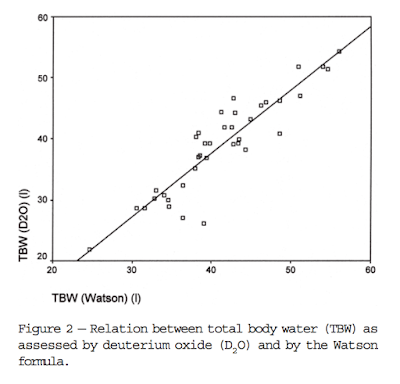Everyone knows the rule of thumb that young males are 60% water, young females are 50% water and the percent body water falls as people age or get fatter.
Going beyond these rules of thumb, how is total body water measured empirically? The gold standard is heavy water dilution.
This works by giving a sample of heavy water and then waiting for it to equilibrate. Then the investigators measure the heavy water content of exhaled water vapor or a blood sample, the fraction of the water that is heavy water will be equivalent to the fraction of total water which is heavy water. Then since one knows the amount of heavy water given to the patient, one can calculate total body water.
When this is done, or when one reviews the primary literature, as was done in this study the numbers are a little different.
The drop in total body water (in red) in men never gets down to 50% as predicted for the elderly, and in women almost all of the numbers are below 50% and the trend to lower percentages through aging holds if you ignore the 9 women over the age of 70. Of note, these patients are not that obese, see BMIs in blue.
The above study lead to the development of the Watson equation to determine total body water. The Watson equation uses age, weight and height for men and height and weight for women:
- Males: TBW (in liters) = 2.447 + (0.09156 × age) + (0.1074 × height) + (0.3362 × weight)
- Females: TBW (in liters) = –2.097 + (0.1069 × height) + (0.3362 × weight)
This study in peritoneal dialysis patients (peritoneum empty) showed surprisingly close relationship (R=0.92) between deuterium dilution and the Watson equation:
Another study of PD patients demonstrated one of my pet peeves, the major effect of obesity has on total body water.
The chart is a bit difficult to understand. The Y axis shows the Watson calculation of total body water minus heavy water dilution. So negative numbers indicates cases where the Watson method underestimates TBW. When the Y-axis is positive the Watson calculation overestimates TBW. The X-axis expresses obesity as body fat over body water. Really? fat over water. You couldn't just graph this versus BMI?
Of course, Nathan covered this first.




